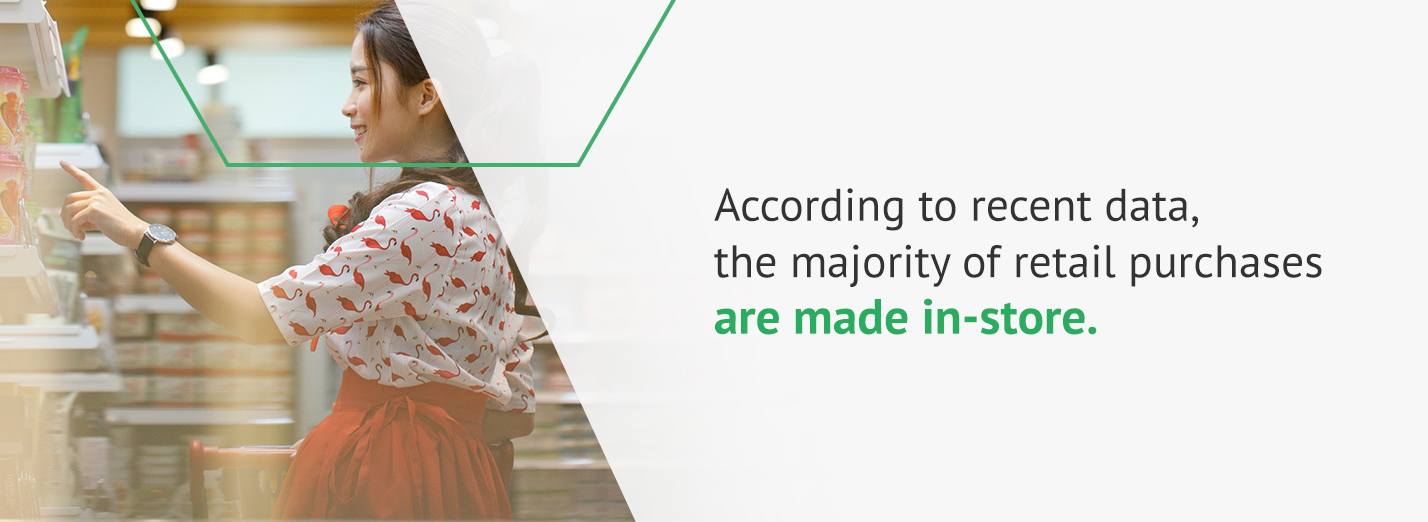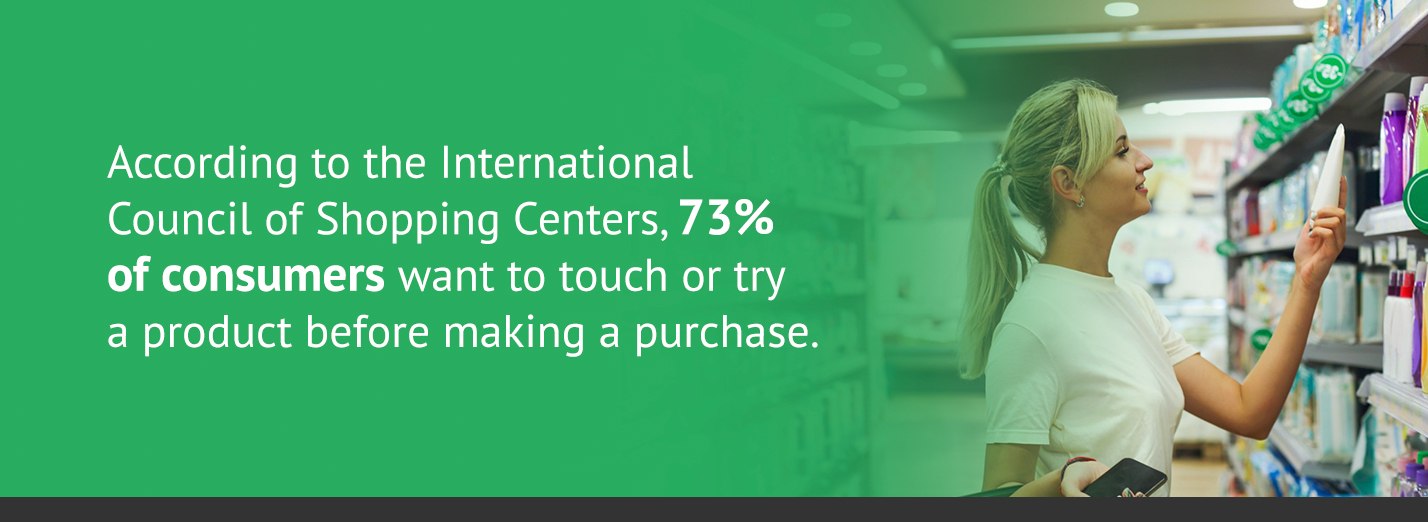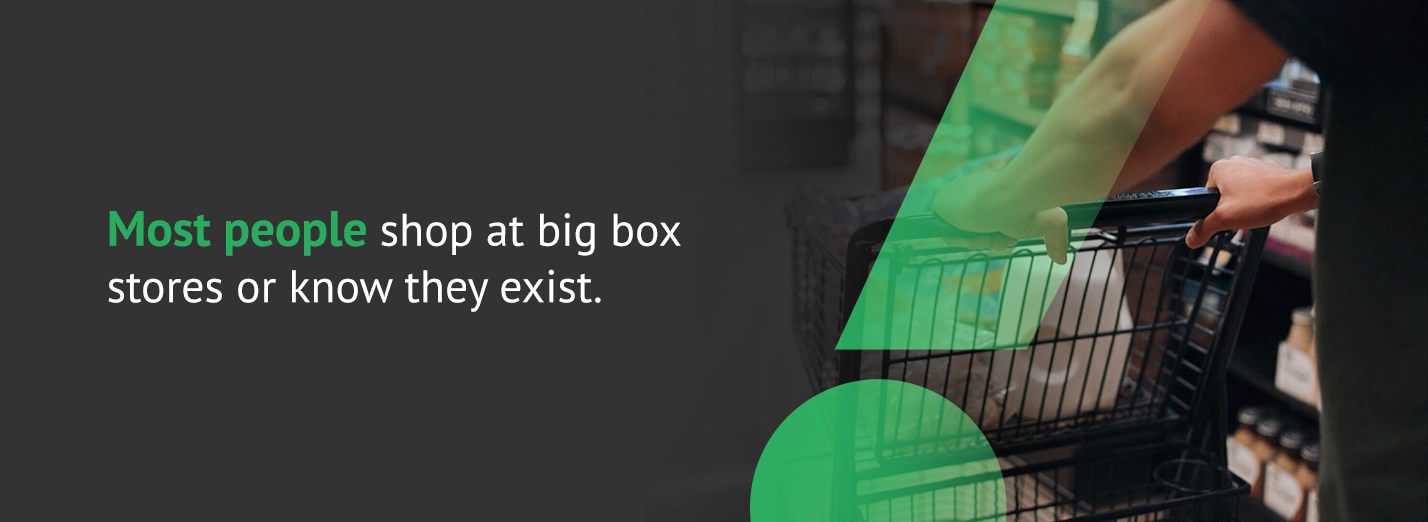Chapter 1: Why Market Your Products in Big Box Stores?
It’s hard to picture a world without big box stores, especially since they’ve been around for over 60 years. In the past, families anticipated trips to these new enormous stores filled with discounted merchandise. They could spend hours shopping and gathering just about everything they needed for their homes.
Things aren’t much different today, and big box stores continue to grow despite fears that consumers are spending less. Even as online shopping becomes more popular, people still prefer to shop inside stores. For example, according to recent data provided by the U.S. Census Bureau, most retail purchases are made in-store. According to a McKinsey and Company report, experts predict e-commerce will only account for 21% of retail sales and 5% of grocery sales by 2023.
Consumers prefer shopping in-store for various reasons, and big box retailers offer prices customers are willing to pay. When it comes to stocking up on consumables, big box stores are hard to beat.
By getting your product into a big box store, you get to be where your potential customers are shopping. You may also get to enjoy the advantage of making your product available on a retailer’s website, potentially getting your item seen by millions of people. Consider that almost 265 million customers visit Walmart’s stores and e-commerce sites each week.
If you’re an entrepreneur, it’s worth weighing the pros and cons of getting your product on the shelves at major retailers. This chapter explores both the advantages and disadvantages of retail outlets and reasons to sell your product at big box stores.
What Are Physical Markets?
In general, a market is a place where buyers can purchase goods or services from a seller. The market may be physical, like a retail store. A physical market allows consumers to meet sellers face-to-face.
Physical retail stores are also called brick-and-mortar stores. According to Statista research, there were 442,597 brick-and-mortar retail stores in the United States in 2019.
A market can also exist online. Online markets do not involve face-to-face contact with sellers. Many of the country’s leading brick-and-mortar stores also operate online. For example, Walmart, The Home Depot and Best Buy were among the most popular online stores in 2018.
Physical Retail vs. Online Retail
Why do consumers continue to shop in stores when it’s so easy to make purchases online? Here are some of the advantages of physical markets and how they can benefit your brand:
- Consumers can touch the product: Consumers may be more likely to purchase your product if they can hold it in their hands first. According to the International Council of Shopping Centers, 73% of consumers want to touch or try a product before purchasing.
- There’s an easier return process: Customers appreciate returning items in a store rather than sending them back to the seller. Some customers may also prefer face-to-face service rather than deal with the hassle of contacting sellers online or over the phone. When customers know they can quickly return a product, they can try a new brand with confidence.
- Consumers spend more money: Consumers may be more likely to open their wallets for a new product in-store because they spend more money when they shop in physical locations overall. One survey found that 71% of shoppers spend $50 or more while shopping in-store versus 54% who spent $50 or more shopping online.
- Customers are more likely to make an impulse buy: Consumers are more likely to make an impulse purchase in-store than online, according to a 2017 survey. One way to encourage impulse buying is to place attractive displays by checkout counters.
- Physical markets enable discovery: Generally, when people shop online, they search for a specific item and ignore everything else. However, when people shop in stores, they are more likely to browse, discover a new product and toss it in their carts.
- In-store shopping provides instant gratification: Rather than waiting for their purchase to arrive in the mail, consumers can buy and try products immediately when they shop in-store. According to a global report by KPMG International, 34% of consumers say they prefer to shop in person to avoid long delivery times.
Considering all of the reasons customers love to shop in person, it’s not likely physical retail stores will go away any time soon — or ever. But, despite the many advantages of retail stores, there are a few downsides to consider. Disadvantages of retail outlets include:
- The store may not be open 24/7: Many brick-and-mortar stores aren’t open 24/7, but online stores allow consumers to shop at any hour. According to the KPMG report, 58% of consumers like to buy items online to shop whenever they want.
- Customers can’t avoid crowds: Fifteen percent of consumers might choose online shopping to avoid crowds. In densely populated areas, this number may be even higher.
- Customers have to wait in line: Eleven percent of shoppers avoid shopping in person to skip checkout lines. When customers shop at home, they only have to click a few buttons to check out.
- Customers need to leave their homes: Thirty-nine percent of consumers enjoy the convenience of shopping online and not having to leave their homes. This means not having to worry about transportation, hazardous weather or getting dressed to shop.
Online stores and physical stores certainly have distinct advantages that’ll keep both types of markets up and running. If you sell your product in a big box store, you may be able to enjoy the best of both worlds since many stores like Walmart and Target also offer online shopping and convenient options such as curbside pickup.
Why Sell at Big Box Stores
You may be wondering why it’s a good idea to reach major retailers instead of mom-and-pop shops. Although there are benefits to working with a small business, such as more flexible store rules, it’s worth considering the advantages of choosing a big box store as your retail partner:
- Large companies may stick around longer: According to the Chamber of Commerce, only 50% of small businesses survive after five years. Although big box stores aren’t immune to the retail market’s volatility, it may be comforting to know that some stores like Walmart have been around for decades and bring in billions of dollars a year.
- You can reach more people: Most people shop at big box stores or know they exist. If you ask someone if they ever heard of Target, for example, it’s highly likely they’ll know what you’re talking about. Smaller stores, however, aren’t visited by as many people and don’t have the same reach.
- You’ll benefit from their marketing strategies: Big box retailers can afford to advertise their company and draw people into their stores. The more people they attract, the more it can benefit you.
- You can evolve with consumers: Big box stores have more money to invest in their stores than smaller retailers. This means they can grow with consumer shopping habits and needs. For example, big box stores might offer online shopping, self-checkout and curbside pickup. Large retailers can also afford to adopt new technologies to make the customer experience even more convenient. According to McKinsey and Company, technology is likely to double store profitability.
- Big box stores are familiar: People like familiar things, from their food to the places they shop. Big box stores are found all over the country, and consumers know what to expect with each location. Familiarity is especially crucial to consumers buying a product for the first time. According to Pew Research Center, 34% of Americans say it’s extremely important to purchase something new from stores or sellers they are familiar with.
Best Products for Big Box Stores
Some items are not meant to be sold in large volumes at low prices, like hand-crafted goods or antiques, for example. Likewise, certain specialty products belong in small niche stores rather than big box markets.
However, some products appeal to a mass audience and can be produced in large quantities quickly. These types of goods are ideal for big box stores like Target or Whole Foods Market. To determine if your product makes the cut, consider if your merchandise is in demand, profitable and consumable. Major retailers thrive on selling consumer packaged goods and often think of strategic ways to encourage impulse buying.
To get your product into a top retailer, consider if you have items that people are likely to buy on impulse, such as:
- Food
- Beer, wine and liquor
- Pharmacy products
- Books and music
- Pet food and supplies
Also, think about what people prefer to buy in-store rather than online. According to a study by PwC, consumers prefer to buy the following products in person rather than online:
- Electronics and computers
- Sports equipment
- Health and beauty products
- Clothing and shoes
- Jewelry
- Household appliances
- Home improvement products
- Furniture
- Groceries
According to the study, the only products that consumers would rather shop for online are books, music, movies, video games and toys.
Overall, big box stores are looking for new products that will help them stay on top of trends and bring a profit. So, if you have a great product that people love to use and want to buy again, you may be the kind of business partner a major retailer seeks.
If you’re ready to learn more about custom displays designed especially for big box stores, please contact us at Creative Displays Now.
Table of Contents
- How to Get Your Product Into Big Box Stores with CDN
- Chapter 1: Why Market Your Products in Big Box Stores?
- Chapter 2: How to Market Your Product to Retailers
- Chapter 3: Find the Right Big Box Store for Your Products
- Chapter 4: How to Approach Retail Stores to Sell Your Product
- Chapter 5: Get Your Products in Stores With Custom Displays



